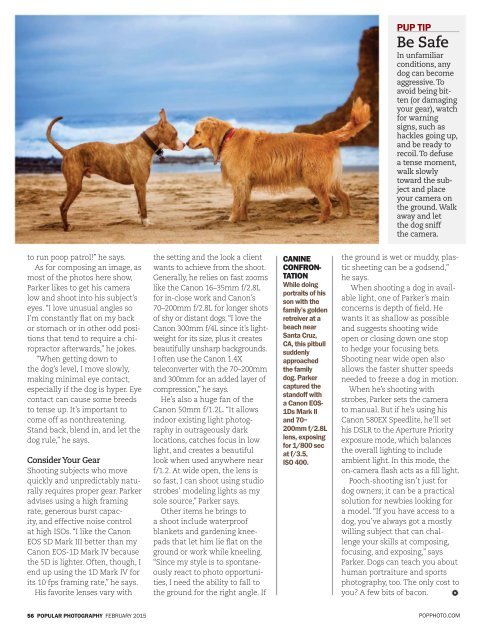Popular Photography - February 2015 USA
You also want an ePaper? Increase the reach of your titles
YUMPU automatically turns print PDFs into web optimized ePapers that Google loves.
PUP TIP<br />
Be Safe<br />
In unfamiliar<br />
conditions, any<br />
dog can become<br />
aggressive. To<br />
avoid being bitten<br />
(or damaging<br />
your gear), watch<br />
for warning<br />
signs, such as<br />
hackles going up,<br />
and be ready to<br />
recoil. To defuse<br />
a tense moment,<br />
walk slowly<br />
toward the subject<br />
and place<br />
your camera on<br />
the ground. Walk<br />
away and let<br />
the dog sniff<br />
the camera.<br />
to run poop patrol!” he says.<br />
As for composing an image, as<br />
most of the photos here show,<br />
Parker likes to get his camera<br />
low and shoot into his subject’s<br />
eyes. “I love unusual angles so<br />
I’m constantly flat on my back<br />
or stomach or in other odd positions<br />
that tend to require a chiropractor<br />
afterwards,” he jokes.<br />
“When getting down to<br />
the dog’s level, I move slowly,<br />
making minimal eye contact,<br />
especially if the dog is hyper. Eye<br />
contact can cause some breeds<br />
to tense up. It’s important to<br />
come off as nonthreatening.<br />
Stand back, blend in, and let the<br />
dog rule,” he says.<br />
Consider Your Gear<br />
Shooting subjects who move<br />
quickly and unpredictably naturally<br />
requires proper gear. Parker<br />
advises using a high framing<br />
rate, generous burst capacity,<br />
and effective noise control<br />
at high ISOs. “I like the Canon<br />
EOS 5D Mark III better than my<br />
Canon EOS-1D Mark IV because<br />
the 5D is lighter. Often, though, I<br />
end up using the 1D Mark IV for<br />
its 10 fps framing rate,” he says.<br />
His favorite lenses vary with<br />
the setting and the look a client<br />
wants to achieve from the shoot.<br />
Generally, he relies on fast zooms<br />
like the Canon 16–35mm f/2.8L<br />
for in-close work and Canon’s<br />
70–200mm f/2.8L for longer shots<br />
of shy or distant dogs. “I love the<br />
Canon 300mm f/4L since it’s lightweight<br />
for its size, plus it creates<br />
beautifully unsharp backgrounds.<br />
I often use the Canon 1.4X<br />
teleconverter with the 70–200mm<br />
and 300mm for an added layer of<br />
compression,” he says.<br />
He’s also a huge fan of the<br />
Canon 50mm f/1.2L. “It allows<br />
indoor existing light photography<br />
in outrageously dark<br />
locations, catches focus in low<br />
light, and creates a beautiful<br />
look when used anywhere near<br />
f/1.2. At wide open, the lens is<br />
so fast, I can shoot using studio<br />
strobes’ modeling lights as my<br />
sole source,” Parker says.<br />
Other items he brings to<br />
a shoot include waterproof<br />
blankets and gardening kneepads<br />
that let him lie flat on the<br />
ground or work while kneeling.<br />
“Since my style is to spontaneously<br />
react to photo opportunities,<br />
I need the ability to fall to<br />
the ground for the right angle. If<br />
CANINE<br />
CONFRON-<br />
TATION<br />
While doing<br />
portraits of his<br />
son with the<br />
family’s golden<br />
retreiver at a<br />
beach near<br />
Santa Cruz,<br />
CA, this pitbull<br />
suddenly<br />
approached<br />
the family<br />
dog. Parker<br />
captured the<br />
standoff with<br />
a Canon EOS-<br />
1Ds Mark II<br />
and 70–<br />
200mm f/2.8L<br />
lens, exposing<br />
for 1/800 sec<br />
at f/3.5,<br />
ISO 400.<br />
the ground is wet or muddy, plastic<br />
sheeting can be a godsend,”<br />
he says.<br />
When shooting a dog in available<br />
light, one of Parker’s main<br />
concerns is depth of field. He<br />
wants it as shallow as possible<br />
and suggests shooting wide<br />
open or closing down one stop<br />
to hedge your focusing bets.<br />
Shooting near wide open also<br />
allows the faster shutter speeds<br />
needed to freeze a dog in motion.<br />
When he’s shooting with<br />
strobes, Parker sets the camera<br />
to manual. But if he’s using his<br />
Canon 580EX Speedlite, he’ll set<br />
his DSLR to the Aperture Priority<br />
exposure mode, which balances<br />
the overall lighting to include<br />
ambient light. In this mode, the<br />
on-camera flash acts as a fill light.<br />
Pooch-shooting isn’t just for<br />
dog owners; it can be a practical<br />
solution for newbies looking for<br />
a model. “If you have access to a<br />
dog, you’ve always got a mostly<br />
willing subject that can challenge<br />
your skills at composing,<br />
focusing, and exposing,” says<br />
Parker. Dogs can teach you about<br />
human portraiture and sports<br />
photography, too. The only cost to<br />
you? A few bits of bacon.<br />
56 POPULAR PHOTOGRAPHY FEBRUARY <strong>2015</strong><br />
POPPHOTO.COM



